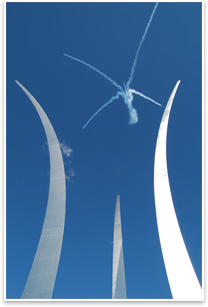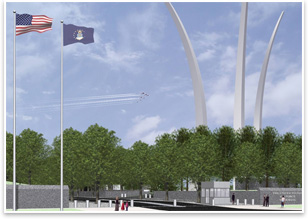Air Force Memorial Dedicated to Integrity, Service, Excellence
 Summary: With President George W. Bush, Secretary of Defense Donald H. Rumsfeld, Secretary of the Air Force Michael W. Wayne, Chief of Staff of the Air Force General T. Michael Moseley, and Chief Master Sergeant of the Air Force Rodney J. McKinley serving as the official party, the U.S. Air Force dedicated its memorial overlooking the Pentagon in Arlington, Va., October 14, the last of James Ingo Freed’s work that he saw into construction. Freed, who died in December 2005, described the design as an effort of “making air tangible, making technology felt.” The picture-perfect autumn day with a crystalline blue sky served as perfect backdrop for the soaring spires that Sec. Wayne called a “brilliant symbol of freedom and the spirit of flight.” Summary: With President George W. Bush, Secretary of Defense Donald H. Rumsfeld, Secretary of the Air Force Michael W. Wayne, Chief of Staff of the Air Force General T. Michael Moseley, and Chief Master Sergeant of the Air Force Rodney J. McKinley serving as the official party, the U.S. Air Force dedicated its memorial overlooking the Pentagon in Arlington, Va., October 14, the last of James Ingo Freed’s work that he saw into construction. Freed, who died in December 2005, described the design as an effort of “making air tangible, making technology felt.” The picture-perfect autumn day with a crystalline blue sky served as perfect backdrop for the soaring spires that Sec. Wayne called a “brilliant symbol of freedom and the spirit of flight.”
The memorial, sited on a promontory overlooking the Pentagon just outside the eastern edge of Arlington National Cemetery, centers on three steel arcs curving up and out, resembling the bomb-burst maneuver of the Air Force Thunderbird Demonstration Team.
 “The Memorial itself is 270 feet high and appears to be soaring,” Freed had said at the September 15, 2004, groundbreaking. “Its array of arcs against the sky evokes a modern image of flight by jet and space vehicles. At the same time, it enshrines the past in permanent remembrance of the pioneers of flight who came before, and pays homage to those of the future.” Construction of the memorial commenced January 15, 2005. “The Memorial itself is 270 feet high and appears to be soaring,” Freed had said at the September 15, 2004, groundbreaking. “Its array of arcs against the sky evokes a modern image of flight by jet and space vehicles. At the same time, it enshrines the past in permanent remembrance of the pioneers of flight who came before, and pays homage to those of the future.” Construction of the memorial commenced January 15, 2005.
Three core values
The site also contains an eight-foot-tall bronze Honor Guard statue by Zenos Frudakis standing near the west entrance. The realistic and close-to human scale invites comparison to the statues near the site of the Vietanam Veterans Memorial. On that edge of the Air Force memorial, Freed also planned “thick rows of mature trees … carefully shaped to intensify the Memorial experience.” Leading from the entrance north to the Glass Contemplation Wall—which features the “missing man” air formation in honor of Air Force dead—is a bluestone-paved path running parallel to a stepped-stone plinth. Two black granite inscription walls at either end of a parade ground complete the plan’s framing of the three arcs whose central granite base features the Air Force star insignia.
 The three Air Force core values—integrity first, service before self, and excellence in all we do—inspired the three arcs, each of which is an equilateral triangle in section. The three grounding points are also the minimum to define a space, Freed had noted. The proportion of the height of the spires to the width of the site defines the memorial in open space. Gen. Moseley remarked that generations serving and generations who will serve “will be motivated and inspired by this memorial.” The three Air Force core values—integrity first, service before self, and excellence in all we do—inspired the three arcs, each of which is an equilateral triangle in section. The three grounding points are also the minimum to define a space, Freed had noted. The proportion of the height of the spires to the width of the site defines the memorial in open space. Gen. Moseley remarked that generations serving and generations who will serve “will be motivated and inspired by this memorial.”
Celebration of 60 years
The asymmetrical spires of different heights appear to move as one drives past. (The site, bounded by the cemetery and major thoroughfares feeding into D.C., the Pentagon, and the adjacent Navy Annex, is bypassed by tens of thousands of people a day, but is not readily accessible to pedestrians.) The site includes bus and car parking.
President Bush noted that with the dedication of the memorial, the Air Force was beginning a year-long celebration of its 60th birthday. “I can think of no better way to start this celebration than by accepting this magnificent memorial in the name of the American people,” he said. The president noted the memorial as an “incredible feat of engineering.”
Ove Arup & Partners engineered the spires, which have reinforced-concrete cores sheathed in 3/4-inch stainless-steel plate and weigh a total of 7,300 tons. Wind force against each spire is resisted with a “ball-in-box” damping system developed by Arup. Each stainless steel box contains large steel-sheathed lead balls whose free-rolling movement resists sway. The tallest tower contains six stacked dampers.
 Off we go . . . Off we go . . .
The ceremony concluded with the Thunderbirds’ flyover and perfect execution of the bomb-burst maneuver directly over the memorial, thrilling all and making as clear as that sapphire sky how Freed’s “soaring spires” had perfectly captured the indomitable spirit and brashly open optimism of the youngest branch of our armed services. As starkly simple as his National Holocaust Museum is richly complex, it is also a tribute to the depth and genius of James Ingo Freed.
In the official program for the ceremony, one whose pages are filled to grateful capacity with military and political sponsors and contributors and patrons, one page jumps out for its simple message and effective use of white space. It reads: “In special recognition, we celebrate the architectural genius of James Ingo Freed, June 23, 1920–December 15, 2005. The Air Force Memorial will forever be a soaring symbol of James Freed’s gift of creativity.”
Mr. Freed, you gave the U.S. Air Force a snappy salute.
Back at you.
—DG and SS
|


 Summary:
Summary: “The Memorial itself is 270 feet high and appears to be soaring,” Freed had said at the September 15, 2004, groundbreaking. “Its array of arcs against the sky evokes a modern image of flight by jet and space vehicles. At the same time, it enshrines the past in permanent remembrance of the pioneers of flight who came before, and pays homage to those of the future.” Construction of the memorial commenced January 15, 2005.
“The Memorial itself is 270 feet high and appears to be soaring,” Freed had said at the September 15, 2004, groundbreaking. “Its array of arcs against the sky evokes a modern image of flight by jet and space vehicles. At the same time, it enshrines the past in permanent remembrance of the pioneers of flight who came before, and pays homage to those of the future.” Construction of the memorial commenced January 15, 2005. The three Air Force core values—integrity first, service before self, and excellence in all we do—inspired the three arcs, each of which is an equilateral triangle in section. The three grounding points are also the minimum to define a space, Freed had noted. The proportion of the height of the spires to the width of the site defines the memorial in open space. Gen. Moseley remarked that generations serving and generations who will serve “will be motivated and inspired by this memorial.”
The three Air Force core values—integrity first, service before self, and excellence in all we do—inspired the three arcs, each of which is an equilateral triangle in section. The three grounding points are also the minimum to define a space, Freed had noted. The proportion of the height of the spires to the width of the site defines the memorial in open space. Gen. Moseley remarked that generations serving and generations who will serve “will be motivated and inspired by this memorial.” Off we go . . .
Off we go . . .